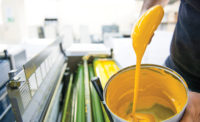The packaging industry, like much of the world around us, is making strides to become more sustainable and environmentally friendly. The flexographic printing market is not exempt from these trends and, as printers begin to feel pressure from customers to become more sustainable, it is important to consider how and where to implement these changes.
With increased concerns about the environment, consumers are now pushing brands to use sustainable practices more than ever. In fact, 66% of consumers and 73% of millennials are willing to pay more for sustainable goods, according to research by Nielsen.
Flexo printers have valuable opportunities to help brands meet those sustainability initiatives. Below are five ways to reach brands looking to go green.
1) Use Less Energy
Advanced technology in flexographic facilities is key to not only reducing waste, but also reducing the amount of energy used. Newer presses feature regenerative drives that allow printers to utilize the equipment’s own inertia to regenerate energy for a later time. As you slow down and stop a machine, that energy is absorbed, stored in capacitators and used when the machine returns to the motoring phase. This means that, once a piece of machinery is up and running, it is essentially running on free, preserved energy.
Other recent innovations, like compressed air dryers, which are powered by electricity rather than natural gas, have enabled printers to utilize alternative forms of energy, such as solar power. Compressed air offers another benefit that forced air doesn’t: heat as a byproduct. As the dryer releases the air, it simultaneously produces hundreds of degrees of additional energy needed for the drying process, creating a more cost-effective and energy-efficient solution.
2) Choose a Press Optimized for Flexible, Recyclable Packaging
Flexographic printing has helped change the packaging industry, since it allows for printing on a wider range of materials than traditional printing presses. With flexographic printing, brands can utilize flexible packaging or recyclable materials without losing print quality or efficiencies when choosing new packaging.
Some printing presses are optimized for printing on unique substrates such as polyethylene, which is recyclable and requires less plastic to produce. Previously, polyethylene and low-gauge films could be barriers to quality printing, as they are thin and difficult to print on.
Now, some flexo printing presses offer high-quality printing capabilities on these materials. New presses can achieve high-quality print on polyethylene and low-gauge films, which means printers can offer brands the opportunity to reduce their use of plastic and increase packaging recyclability without sacrificing quality.
3) Use Less Water and Fewer Chemicals
Flexographic printers can also support sustainability initiatives by using water- and solvent-saving printing and cleaning processes, which reduces water waste and contamination. Laser cleaning is one way to reduce the use of water and chemicals, as laser cleaners don’t require liquids, chemicals or air supplies, yet achieve deep cleaning. Laser cleaning allows the anilox to perform at correct volumes — saving time, ink and waste, and prolongs the life of anilox rolls.
Flexo printers implementing methods like these can help brands reach their goal of contributing to a cleaner environment.
4) Utilize Sustainable Inks
Water-based inks are an eco-friendly alternative to solvent-based inks, as they include fewer volatile organic compounds, which can be hazardous or have implications for the environment when evaporated into the air. Water-based inks are made from renewable resources. No fossil fuels or petroleum are required to produce them, and no chemicals are required for cleanup, which helps prevent hazardous materials from entering the water supply. Printing with water-based inks helps printers and brands alike get closer to their sustainability goals.
5) Innovative Equipment
Think about what is arguably the most important piece of any flexographic operation: the printing press. AI technology, such as camera-based automatic impression and register systems, takes operator error and guesswork out of the equation as presses adjust to address print inaccuracies without human intervention. Similarly, recent anti-bounce innovations utilize algorithms to monitor, adjust and address bounce in real time, helping to reduce both run times and unnecessary waste. Flexographic printers can gain a leading edge in the industry by taking advantage of these advancements to technology.
Presses and machinery are major investments that printers expect to last for years, if not decades, and upgrading for the sole purpose of enhancing sustainability may not seem realistic. There are options, however, that have significantly smaller price tags and still take a step in the “green” direction.
Work with your equipment manufacturer to identify pieces of machinery that can be upgraded through retrofitted components and controls. Facilities can also kick-start their sustainability initiatives without blowing the budget by upgrading smaller pieces of equipment, such as dryers and anilox cleaners, rather than presses.
As this market shows few signs of slowing down, key players within the CPG sector will continue to favor green suppliers and partners. Flexographic printers need to adopt sustainability initiatives and use these efforts as differentiators to lead the charge.
Sign up for Converters Expo (August 24-25) and be a part of the virtual plant tour at Paper Converting Machine Company.



